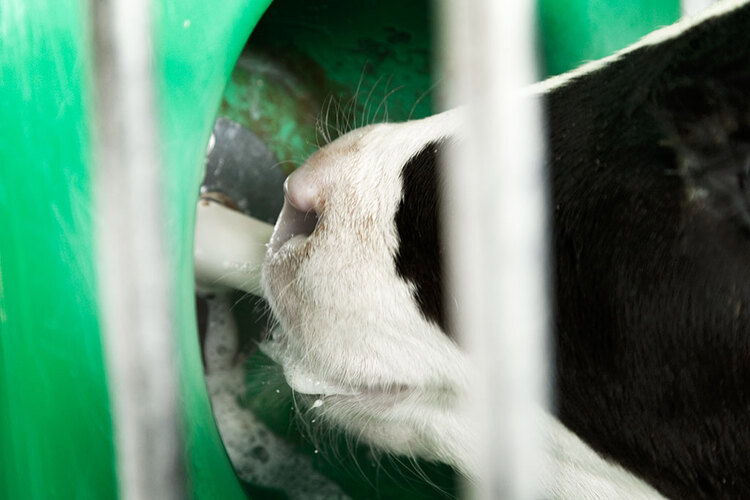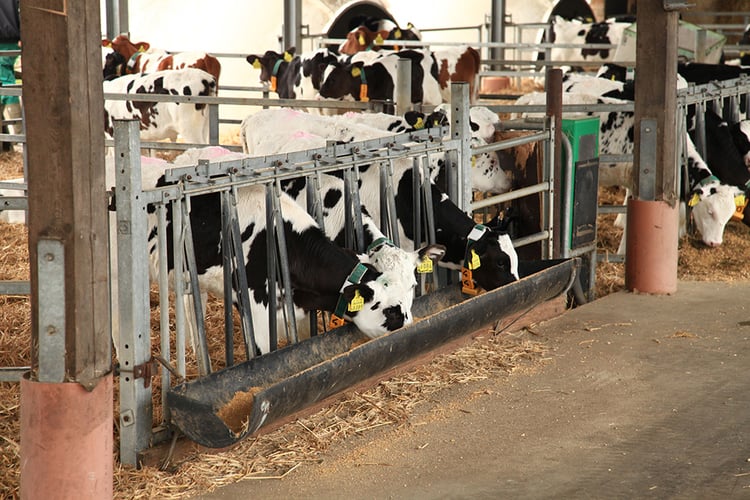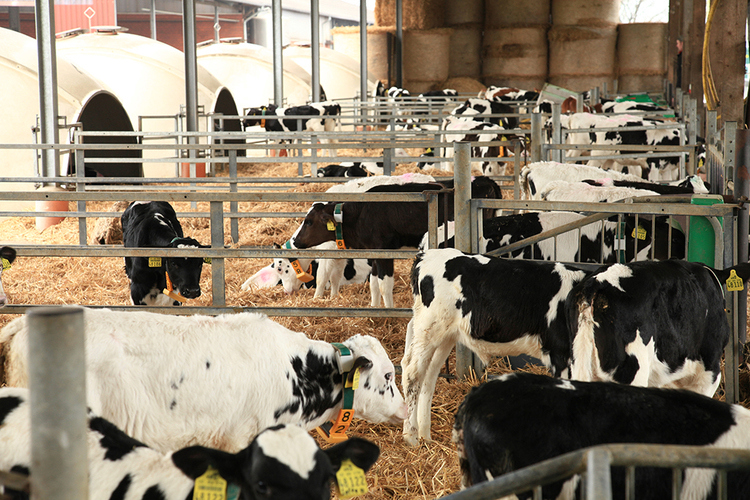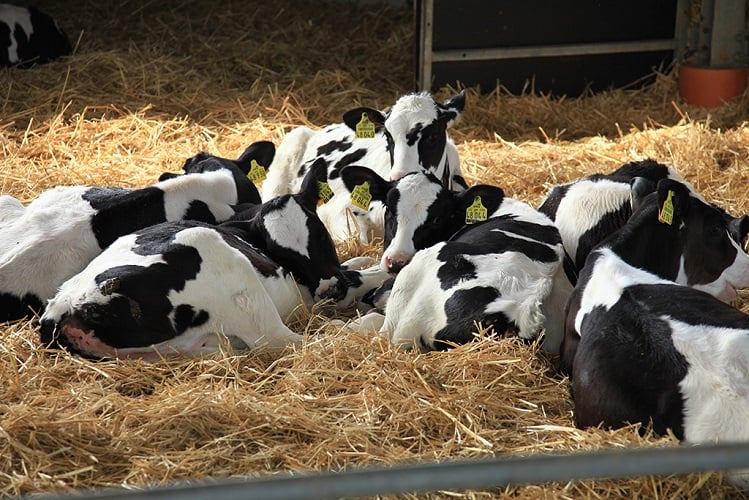- LifeStart
- Weaning strategies
Key takeaways from the research:
-
Weaning calves based on their ability to eat solid feed instead of weaning at a set age has many advantages
-
Using automated feeders to adjust milk amounts around weaning based on starter feed intake reduces costs and increases the ability to wean based on individual calf needs.
-
Weaning calves based on their starter intake results in greater average daily gain than weaning at a set age of 6 to 8 weeks.
-
Weaning calves based on their ability to eat solid feed is less costly than weaning calves at an age of 12 weeks, but results in similar growth.

What is the best method for weaning dairy calves fed high planes of nutrition via an automatic feeder?
Several factors should be considered when choosing a method for feeding dairy calves in the pre-weaning period, such as cost-effectiveness, calf growth and health. Increasingly, dairy farmers are turning to automated feeders for pre-weaned dairy calves. Automated feeders:
- decrease labour costs[1]
- increase the ability to precisely control individual intakes of both liquid and solid feeds[2]
- facilitate the feeding of higher amounts of milk or milk replacer which leads to higher pre-weaning growth[3], leading to higher eventual milk yield[4] and greater lifetime production.
If higher amounts of milk are fed, should calves be weaned at a fixed early age such as 6 or 8 weeks, even if this often results in a weaning dip?[5] It is important to understand that starter feed intakes are generally reduced when feeding larger amounts of milk replacer[6]. This could lead to reduced growth and greater signs of hunger if weaning takes place at an early age[7]. One way to avoid this specific pitfall is simply to wean at a later age[8], but this can be quite costly.
In their research 'Using automated feeders to wean calves fed large amounts of milk according to their ability to eat solid feed', de Passillé and Rushen[9] explore the idea of weaning calves fed a higher plane of nutrition based on their individual starter intake (WSI) rather than at a fixed age. They compared this with weaning at a fixed early age (48 days = EW) and a fixed later age (89 days = LW). They took several factors into account including feed and energy intakes, weight gain and behaviour both during and after weaning.
Study design
A total of 56 female Holstein calves were included in the study. They were all fed 4L of colostrum within 6 hours of birth and were placed in individual pens until they were 5 days of age. While in their individual pens, calves had ad libitum access to waste milk but were not provided water or starter. At 5 to 6 days of age, they were transferred to group pens of 5 to 9 individuals, based on 3 different weaning strategies and were fed milk and starter from automated feeders. Calves were allowed 12L/d of pasteurized milk and had ad libitum access to calf starter, grass hay and water, via automated feeders which weighed the intake of each calf at each meal. All calves were weighed once a week via an electronic scale.
- One group of calves was weaned early (EW, n = 14), beginning at 40 days, with their milk allowance gradually being reduced until being fully weaned at day 48.
- Another group was weaned late (LW, n = 14), receiving their full allotment of 12 L/d up to day 80, with their milk being gradually reduced until being fully weaned at day 89.
- The final group was weaned based on their starter intake amounts (WSI, n = 28), receiving their full allotment of milk until they had consumed an average of 200 g/d of starter during the previous three days (this happened at 54.7 days on average), with their milk allotment gradually reduced to zero when they had consumed an average of 1400 g/d of starter for previous three days (this happened at 75.8 days on average).
Effects on weight, average daily gain and behaviour
At week 10, the EW calves were lighter (84.5 kg) than both WSI (90.6 kg) and LW (94.9 kg) calves. By week 13, the weight of the EW calves (108.2 kg) still lagged behind the other two groups, but the gap between the LW calves (115.9 kg) and the WSI calves (115.2 kg) had narrowed.
Likewise, between week 3 and week 13, EW calves had the lowest average daily gain (1.56 kg p/d), followed by the WSI calves (1.80 kg p/d) and the LW calves (1.85 kg p/d). During the actual weaning period, three of the EW calves lost weight. All the WSI and LW calves gained weight, with the average daily gain during weaning being 0.15 kg for the EW calves, 0.96 kg for the WSI calves and 1.21 kg for the LW calves.
Unrewarded visits to the milk feeder, considered to be a sign of hunger[10], were significantly more frequent for the EW calves, both during and just after weaning than for the other two treatments.
Advantages of weaning based on ability to eat solid feed
The WSI calves achieved the same weight at 13 weeks as the LW calves but were weaned on average 2 weeks earlier than the LW calves. With milk feeding being more expensive than feeding starters, weaning based on a calf's ability to eat solid feed seems to provide an economic advantage. Early weaning does greatly reduce the amount of milk a calf drinks while increasing their starter intake, but this method was less efficient in this study. It also resulted in a significant growth dip at weaning, leading to lower body weight for at least 6 to 8 weeks post-weaning. Using automated feeders to adjust each individual calf's milk allowance based on their ability to consume starter results in intermediate weaning age, between EW and LW, with the advantage of reduced consumption of milk and increased consumption of starter, but with the achievement of similar weights as the LW calves.
The ability to adjust the weaning age for each individual calf is just one of the many advantages of automated feeders. They also facilitate the consumption of larger amounts of milk, which also helps to maintain higher body weights up to and through weaning.
References
[1] Kung, L., Jr., S. Demarco, L. N. Siebenson, E. Joyner, G. F. W. Haenlein, and R. M. Morris. 1997. An evaluation of two management systems for rearing calves fed milk replacer. J. Dairy Sci. 80: 2529–2533.
[2] Roth, B. A., E. Hillmann, M. Stauffacher, and N. M. Keil. 2008. Improved weaning reduces cross-sucking and may improve weight gain in dairy calves. Appl. Anim. Behav. Sci. 111:251–261. And de Passillé, A. M., and J. Rushen. 2012. Adjusting the weaning age of calves fed by automated feeders according to individual intakes of solid feed. J. Dairy Sci. 95:5292–5298.
[3] Khan, M. A., D. M. Weary, and M. A. G. von Keyserlingk. 2011. Invited review: Effects of milk ration on solid feed intake, weaning, and performance in dairy heifers. J. Dairy Sci. 94:1071–1081. And, Miller-Cushon, E. K., and T. J. DeVries. 2015. Invited review: Development and expression of dairy calf feeding behaviour. Can. J. Anim. Sci. 95: 1–10.
[4] Bach, A. 2012. Ruminant nutrition symposium: Optimizing performance of the offspring: Nourishing and managing the dam and postnatal calf for optimal lactation, reproduction, and immunity. J. Anim. Sci. 90:1835–1845. And, Soberon, F., E. Raffrenato, R. W. Everett, and M. E. Van Amburgh. 2012. Preweaning milk replacer intake and effects on long-term productivity of dairy calves. J. Dairy Sci. 95:783–793.
[5] de Passillé, A. M., T. F. Borderas, and J. Rushen. 2011. Weaning age of calves fed a high milk allowance by automated feeders: Effects on feed, water, and energy intake, behavioral signs of hunger, and weight gains. J. Dairy Sci. 94: 1401–1408. Eckert, E., H. E. Brown, K. E. Leslie, T. J. DeVries, and M. A. Steele. 2015. Weaning age affects growth, feed intake, gastrointestinal development, and behavior in Holstein calves fed an elevated plane of nutrition during the preweaning stage. J. Dairy Sci. 98: 6315–6326. And, Miller-Cushon and Devries, 2015. Op cit.
[6] Jensen, M. B. 2006. Computer-controlled milk feeding of group-housed calves: The effect of milk allowance and weaning type. J. Dairy Sci. 89: 201–206. And, Borderas, T. F., A. M. B. de Passillé, and J. Rushen. 2009. Feeding behavior of calves fed small or large amounts of milk. J. Dairy Sci. 92: 2843–2852.
[7] Borderas et al., 2009. Op cit.
[8] de Passillé at al., 2011. Op cit. And, Eckert et al., 2015. Op cit.
[9] de Passillé, A.M. and J. Rushen. 2016. Using automated feeders to wean calves fed large amounts of milk according to their ability to eat solid feed. J. Dairy Sci. 99: 3578-3583.
[10] Jensen, M. B., and L. Holm. 2003. The effect of milk flow rate and milk allowance on feeding related behaviour in dairy calves fed by computer controlled milk feeders. Appl. Anim. Behav. Sci. 82:87–100. And, De Paula Vieira, A., V. Guesdon, A. M. de Passillé, M. A. G. von Keyserlingk, and D. M. Weary. 2008. Behavioural indicators of hunger in dairy calves. Appl. Anim. Behav. Sci. 109:180–189.



